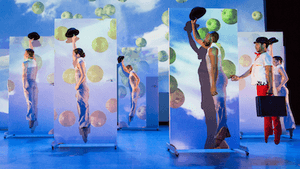Stay in the Loop
BSR publishes on a weekly schedule, with an email newsletter every Wednesday and Thursday morning. There’s no paywall, and subscribing is always free.
Lost memories and vibrant dreams
BalletX 2016 Summer Series with Klip Collective

“We’re always living in someone's golden age,” Tom Stoppard's elder A.E. Housman quipped in The Invention of Love. This point applies not just to eras (what would have to happen politically for future Americans to view the current age as gilded?), but to art, genres within art, and I would argue, media artists employ.
Take the case of video technology in dance. Hailed as a positive change by the Guardian’s Judith Mackrell, I’ve seen it used multiple times this season, including a spectacular fusion of choreography and imagery in Andonis Foniadakis’s Kosmos with the Montreal Jazz Ballet. In the last five minutes of his piece, designers bathed the dancers in a shimmering white and silver rainfall (that reminded me of The Matrix) and unified the piece thematically while pointing with hope to a future.
Were that trend to continue, future me would no doubt look back on the minimal but cohering employ of technology by Foniadakis as emblematic of a period in which choreographers and impresarios wielded lighting, video, and technology as implements in an toolbox. They served the goal of art while pushing an entire genre forward to something historically seen as better (the total-art of The Ballet Russes would provide a similar example for many).
The two pieces on hand during BalletX’s Summer Series would prove a little more divisive. Future dance historians would have equal ammo for the arguments that video became either an overbearing distraction or an imaginative enhancement of a choreographic totality.
Memories and fragments
Matthew Neenan titled his new work Identity without Attribute, but he could have just as easily called it “Iteration without (Much) Variation.” Neenan took the title from the writings of his patron and friend Tony Hamilton, who passed away from Alzheimer’s in 2015.
Philadelphia design firm Klip Collective provides the video and sound design for the piece, which opens with a backdrop of concentric circles radiating outward from the shadowy image of a woman’s head. Dancer Caili Quan kneels at the rear of the stage, her presence throughout signifying Hamilton.
Quan gives a poignant performance, her gaze introspective, her face emotive, hesitant, often afraid. Dancers leap across the stage before her like fragments of memories, lingering, outside her focus. The choreography and tone, while dark, includes many of Neenan’s spritely, spirited touches. Chloe Felesina and Daniel Mayo share a combative duet that concretely grounds what is on the whole, a series of otherwise indistinguishable, repetitive sequences.
Klip Collective’s contributions provide far more variation. Their backdrops start with geometric shapes (triangles, orbs trapped within rectangles, like memories bouncing inside a skull). These images move across the back wall, lines radiate outward from a circle at the apex of a giant triangle, cross-sections of parallelograms spread out, dominating the experience. Electronic music drones and pulsates before the original concentric circles collapse back upon the image of a woman’s head.
Thematically, Neenan pays a dark tribute to his friend’s experiences, crystallizing the notion of anguish that stems from fading capacity, and a longing, embodied by Quan’s performance, for a repose from the decline. But the lack of variety in movement and expression let the video take center stage.
An homage to Magritte
Annabelle Lopez Ochoa’s Bonzi paid its own homage to the surrealist painter Rene Magritte, with whom she shares a hometown in Belgium. While both pieces, during their 45-minute duration, are engaging, Lopez’s elicited laughter and delight, but simply went on too long.
Bonzi depicts the disconnected narrative of a man with a briefcase (Edgar Anido), reminding from the start of Magritte’s “The Son of Man” and “The Interpretation of Dreams.”
And a pop-y, playful, and fun dream it is! As the remainder of the company hides and crouches behind doors on wheels, Anido knocks, heaves his luggage over their doorframes, and chases the roving entryways across the stage.
Here, Klip Collective creates a blue sky overhead (from Magritte’s “Empire of Light”), with overlays of birds, umbrellas, and a raining torrent of bowler hats. Anido’s journey reflects the surrealism of Magritte’s work; as with a door that remains closed, we don’t see what lies behind the imagery. The visuals accentuate without dominating, adding to Ochoa’s prop-driven choreography of hats and umbrellas flipped from hand to hand, and enabling her to create moments of artistry that, in their own genre-based right, acknowledge a debt to her countryman, while standing on the steady footing of her own contribution.
What, When, Where
BalletX Summer Series in collaboration with Klip Collective, July 6-17, 2016 at the Wilma Theater, 265 S. Broad St., Philadelphia. (215) 546-7824 or balletx.org.
Sign up for our newsletter
All of the week's new articles, all in one place. Sign up for the free weekly BSR newsletters, and don't miss a conversation.

 Jim Rutter
Jim Rutter